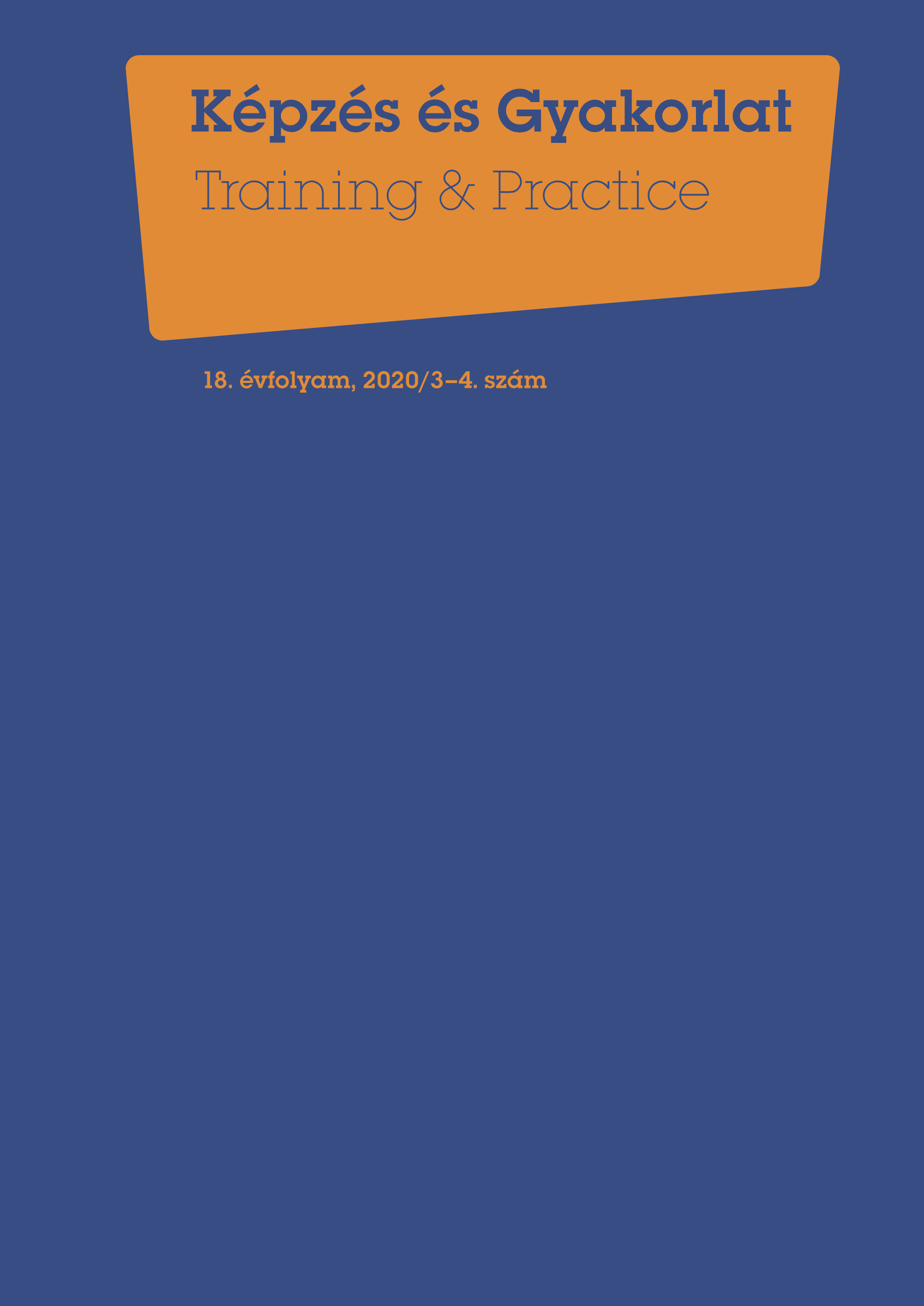Unalom és kontrollvesztés: a problémás okostelefon-használatot előrejelző pszichológiai változók vizsgálata magyar fiatalok mintáján
DOI:
https://doi.org/10.17165/TP.2020.3-4.4Resumen
A fiatal generációk életében egyértelmű az okostelefonok térnyerése. A velük kapcsolatos viselkedési függőség, a problémás okostelefon-használat kutatott jelenség, mely esetében számos rizikó- és védőfaktort azonosítottak már. Kutatásunkban 14–28 év közötti magyar fiatalok mintáján vizsgáltunk pszichikai változókat, melyek előjelezhetik a problémás használatot. A bináris és többszörös logisztikus regressziók alapján az unalomra való hajlam és az önkontroll csökkenése jósolja be leginkább a vizsgált jelenséget, melyet ezek mellett a relatív ingerszegénység elkerülése iránti igény és a viselkedési függőségeket irányító kényszeresség is magyarázhat.
Referencias
Berger, S., Wyss, A. és Knoch, D. (2018). Low self-control capacity is associated with immediate responses to smartphone signals. Computers in Human Behavior, 86. sz. pp. 45- 51. DOI: https://doi.org/10.1016/j.chb.2018.04.031
Bianchi, A. & Phillips, J. G. (2005). Psychological predictors of problem mobile phone use. CyberPsychology & Behavior, 8. évf. 1. sz. pp. 39-51. DOI: https://doi.org/10.1089/cpb.2005.8.39
Campbell-Sills, L. & Stein, M. B. (2007). Psychometric analysis and refinement of the Connor-Davidson Resilience Scale (CD-RISC): Validation of a 10-item measure of resilience. Journal of Traumatic Stress, 20. évf. 6. sz. pp.1019-1028. DOI: https://doi.org/10.1002/jts.20271
Choi, S-W., Mok, J. Y., Kim, H. S. et al. (2014). Risk and protective factors associated with problematic smartphone use in university students. The Canadian Journal of Addiction, 5. évf. 2. sz. p. 28. DOI: https://doi.org/10.1097/02024458-201406000-00027
Csibi, S., Demetrovics, Zs. és Szabó, A. (2017). Az Okostelefon-használat Megvonási Tünetskála (OMT) validálása iskolás gyermekekkel. Psychiatria Hungarica, 32. évf. 3. sz. pp. 307-312.
Demetrovics, Zs. (2013). Viselkedési addikciók: spektrumszemléletű kutatások [Akadémiai nagydoktori értekezés]. Eötvös Loránd Tudományegyetem, Budapest.
Demetrovics, Zs., Szeredi, B. és Nyikos, E. (2004). A Problémás Internethasználat Kérdőív bemutatása. Psychiatria Hungarica, 19. évf. 2. sz. pp. 141-160.
Elhai, J. D., Vasquez, J. K., Lustgarten, S. D. et al. (2017). Proneness to Boredom Mediates Relationships Between Problematic Smartphone Use With Depression and Anxiety Severity. Social Science Computer Review, DOI: https://doi.org/10.1177/0894439317741087
Farmer, R., & Sundberg, N. D. (1986). Boredom proneness: The development and correlates of a new scale. Journal of Personality Assessment, 50. évf. 1. sz. pp. 4-17. Fordította: Horváth Gábor [online] http://www.unalom.hu/unalomra_valo_hajlam_skala.pdf [2020. június 29.] DOI: https://doi.org/10.1207/s15327752jpa5001_2
Griffiths, M. D. (1998). Internet addiction: Does it really exist? In: J. Gackenbach (Ed.), Psychology and the internet: Intrapersonal, interpersonal, and transpersonal implications, (pp. 61-75). San Diego: Academic Press.
Hoyle, R. H., Stephenson, M. T., Palmgreen, P., Lorch, E. P. és Donohew, L. (2002). Reliability and validity of scores on a brief measure of sensation seeking. Personality and Individual Differences, 32. évf. 3. sz. pp. 401-414. DOI: https://doi.org/10.1016/S0191-8869(01)00032-0
Járai, R., Vajda, D., Hargitai, R., Nagy, L. et al. (2015). A Connor-Davidson Reziliencia Kérdőív 10 itemes változatának jellemzői. Alkalmazott Pszichológia, 15. évf. 1. sz. pp. 129-136.
Johnson, S. B. & Blum, R. W. (2012). Stress and the brain: How experiences and exposures across the life span shape health, development, and learning in adolescence. Journal of Adolescent Health, 51. évf. 2. sz. pp. S1-S2. DOI: https://doi.org/10.1016/j.jadohealth.2012.06.001
Kim, H-K. & Davis, K. E. (2009). Toward a comprehensive theory of problematic Internet use: Evaluating the role of self-esteem, anxiety, flow, and the self-rated importance of Internet activities. Computers in Human Behavior, 25. évf. 2. sz. pp. 490-500. DOI: https://doi.org/10.1016/j.chb.2008.11.001
King, D. L., Delfabbro, P. H., Billieux, J. és Potenza M. N. (2020). Problematic online gaming and the COVID-19 pandemic. Journal of Behavioral Addictions, 9. évf. 2. sz. pp. 184-186. DOI: https://doi.org/10.1556/2006.2020.00016
Lin, Y-H., Chang, L-R., Lee, Y-H., Tseng, H-W. és Kuo, T.B.J. (2014). Development and Validation of the Smartphone Addiction Inventory (SPAI). PLoS ONE, 9. évf. 6. sz. e98312. DOI: https://doi.org/10.1371/journal.pone.0098312
Liu, C., & Ma, J. (2018). Social support through online social networking sites and addiction among college students: The mediating roles of fear of missing out and problematic smartphone use. Current Psychology, 39. évf. pp. 1892-1899. DOI: https://doi.org/10.1007/s12144-018-0075-5
Luszczynska, A., Diehl, M., Gutiérrez-Dona, B., Kuusinen, P. és Schwarzer, R. (2004). Measuring one component of dispositional self-regulation. Attention control in goal pursuit. Personality and Individual Differences, 37. évf. 3. sz. pp. 555-566. DOI: https://doi.org/10.1016/j.paid.2003.09.026
Magyaródi, T., Nagy, H., Soltész, P., Mózes, T. és Oláh, A. (2013). Egy újonnan kidolgozott flow állapot kérdőív kimunkálásának és pszichometriai jellemzőinek bemutatása. Pszichológia, 33. évf. 1. sz. pp. 15-36. DOI: https://doi.org/10.1556/Pszicho.33.2013.1.2
Mayer, K., Lukács, A. és Pauler, G. (2012). A 8-tételes Szenzoros Élménykeresés Skála (BSSS- 8) magyarországi adaptálása. Mentálhigiéné és Pszichoszomatika, 13. évf. 3. sz. pp. 297-312. DOI: https://doi.org/10.1556/Mental.13.2012.3.3
Papp-Zipernovszky, P., Kékesi, M. Z., és Jámbori, Sz. (2017). A Multidimenzionális Észlelt Társas Támogatás Kérdőíc magyar nyelvá validálása. Mentálhigiéné és Pszichoszomatika, 18. évf. 3. sz. pp. 230-262. DOI: https://doi.org/10.1556/0406.18.2017.011
Patalay, P., & Gage, S. H. (2019). Changes in millennial adolescent mental health and healthrelated behaviours over 10 years: a population cohort comparison study. International Journal of Epidemiology, 48. évf. 5. sz. pp. 1650-1664. DOI: https://doi.org/10.1093/ije/dyz006
Rosenberg, M. (1965). Society and the adolescent self-image. Princeton, NJ: Princeton University Press. DOI: https://doi.org/10.1515/9781400876136
Rozgonjuk, D., Elhai, J. D. & Hall, B. J. (2019). Studying Psychopathology in Relation to Smartphone Use. In: Baumeister H., Montag C. (Eds.) Digital Phenotyping and Mobile Sensing. Studies in Neuroscience, Psychology and Behavioral Economics, (pp. 185-199.), Cham: Springer. DOI: https://doi.org/10.1007/978-3-030-31620-4_11
Sallay, V., Martos, T., Földvári, M., Szabó, T. és Ittzés, A. (2014). A Rosenberg Önértékelés Skála (RSES-H): alternatív fordítás, strukturális invariancia és validitás. Mentálhigiéné és Pszichoszomatika, 15. évf. 3. sz. pp. 259-275. DOI: https://doi.org/10.1556/Mental.15.2014.3.7
Sohn, S., Rees, P., Wildridge, B. et al. (2019). Prevalence of problematic smartphone usage and associated mental health outcomes amongst children and young people: a systematic review, meta-analysis and GRADE of the evidence. BMC Psychiatry, 19. évf. 356.. DOI: https://doi.org/10.1186/s12888-019-2393-z
Wang P., Lei, L., Wang, X., Nie, J. et al. (2018). The exacerbating role of perceived social support and the "buffering" role of depression in the relation between sensation seeking and adolescent smartphone addiction. Personality and Individual Differences, 130. sz. pp. 129-134. DOI: https://doi.org/10.1016/j.paid.2018.04.009
Xin, M., Xing, J., Pengfei, W., Houru, L. et al. (2018). Online activities, prevalence of Internet addiction and risk factors related to family and school among adolescents in China. Addictive Behavior Reports, 7. évf. pp. 14-18. DOI: https://doi.org/10.1016/j.abrep.2017.10.003
Descargas
Publicado
Número
Sección
Licencia
Derechos de autor 2020 Kiss Hedvig, Pikó Bettina

Esta obra está bajo una licencia internacional Creative Commons Atribución-NoComercial-SinDerivadas 4.0.












